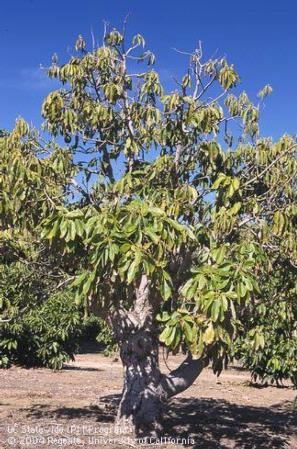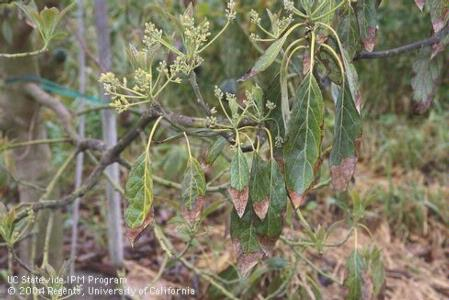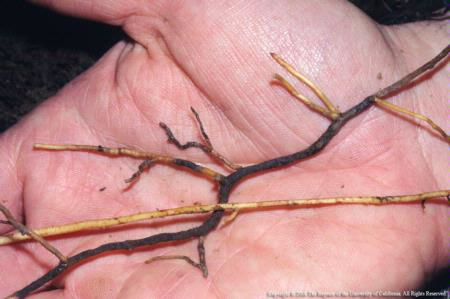
Posts Tagged: cinnamomi
Mature Compost Does NOT Kill Phytophthora
A recent article in California Agriculture highlights something that we have found in raw organic materials that have been used in mulches for controlling Avocado Root Rot – Phytophthora cinnamomi. The most active stage of a material in the process of composting, is the initial one where all the bacteria and fungi are fighting to consume the easily decomposable sugars and light fraction organics. That's when the material heats up and various gases, such as ethylene, ammonia and others are released. This is the most competitive time in decomposition and Phytophthora just can't compete. In fact, it becomes a food source for the antagonistic fungi, since its cell wall is made of cellulose the material that many leaves are made of. In releasing exudates to decompose cellulose, the Phytophthora is decomposed, as well. As the cellulose is decomposed and disappears more resistant materials remain. A mature compost, is therefore a much more stable material than a raw one. It still has nutritional benefits, as well as physical effects on soil when it is incorporated, but has a lesser impact on Phytophthora.
Compost is used as a soil amendment, largely because it is relatively stable biologically and has nutritional/physical effects. Incorporating raw organic matter into the soil and then planting has its restrictions and should be done cautiously. But as a mulch (material applied to the soil surface) there are fewer problems, as long as some common sense is used. Like don't pile it up against plant stems which keeps moisture and conditions for disease around the plant crown. And there are several other qualifiers, such as don't apply it so thickly that the soil never dries out and becomes a problem in walking across it.
So, read this interesting story of what happens to Phytophthora when introduced into a mature compost:
This is also a great web site to read about other UC related agriculture and natural resource research. Sign up.

compost pile
Avocado Dieback – Blight vs. Phytophthora vs. Lack of Light
When you see dieback in an avocado it could be due to several reasons, and here are three very common causes of dieback, one of which has been especially common when there is little rain. The first major cause of dieback is an overgrown tree where there is no light that penetrates into the canopy. Branches with leaves in a darkened interior will naturally shut down and dieback, leaving these twiggy dried out branches. This is a natural process whereby the tree just gets rid of leaves that are not performing.
Another cause of dieback is our old friend Avocado Root Rot, Phytophthora cinnamomi. This causes dieback, also called “stag horning” because of the dead branches standing out from the surrounding canopy. This is normally accompanied by a thinning canopy with smaller, yellow leaves and a lack of leaf litter because of lack of energy. It's also hard to find roots and if they are found, they are black at the tips and brittle.
http://www.ipm.ucdavis.edu/PMG/r8101311.html
The third major cause of dieback is a result of water stress. This shows up with low water pressure, at the top of the hill where the most wind occurs, where a sprinkler gets clogged, when the irrigation schedule is not meeting tree's needs or when there is not adequate rainfall to get sufficient leaching. And after four years of drought, this is very common. This appears as dead spots in the canopy, a branch here and there where the leaves have died and are still hanging. It's been called “salt and pepper” syndrome, because it can have a few branches here and there that have died back while the rest of the canopy is normal, the leaves are normally sized and green. In young trees, in severe cases, the fungus that causes this blight can work its way down to the graft union and kill the tree. In mature trees, it just causes an unthrifty look to the tree. Although we have always seen this problem in avocado orchards, this has become a very common affliction in orchards these last few years
http://www.ipm.ucdavis.edu/PMG/r8101311.html
1) Lack of light dieback
2) Phytophthora cinnamomi dieback
3) Stem and Leaf Blight

lack of sun

root rot vs healthy

stem blight
Signs of Avocado Root Rot
In the last two weeks I’ve been out to see groves that have root rot, yet the growers did not recognize the signs. Two years of drought and use of salt loaded water have put stress on trees and made them more susceptible to root rot. Although irrigation management can bring about the symptoms of root rot – small, yellow, tip-burned leaves – because the tree in both cases is seeing a lack of water. I thought it would be appropriate to review the symptoms of avocado root rot.
What to look for:
Small, yellow, tip-burned leaves
Thin canopy
Die-back in the canopy, causing stag-horning (dead stems)
Little or no new leaf growth, hardened look to the leaves
Few or no leaves on the ground (tree doesn’t have energy to produce leaves)
Profuse flowering and small fruit
Sunburned fruit from reduced canopy
Then get on your knees and dig around in the wetted area of the root zone
Do you find roots in the top 3 inches of soil? NO, that’s a bad sign
Do you find any white root tips (it’s hard to find these when the soil is cold in the winter)? NO, that’s a bad sign.
Do you find black roots? Yes, that’s a bad sign.
These are all field diagnostics for avocado root rot. You can also sample roots and send them in for lab analysis, but in the winter, the root rot organisms are not active and you can actually get a false negative. Meaning the lab won’t pick it up and you then think you don’t have the disease. Use field clues to figure out whether you have root rot. Then figure out why you have it. It usually boils down to the amount and timing of water, but there are many other factors, such as water quality, fruit load, topworking and other stresses that can bring on the disease.
Images. Root rot in canopy, leaves and roots

root rot canopy

root rot leaves

root rot roots
